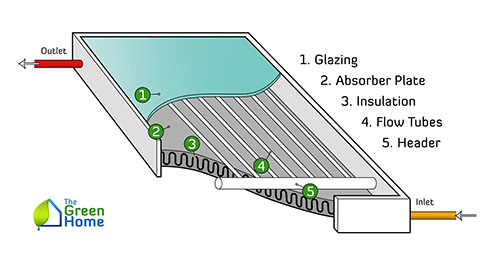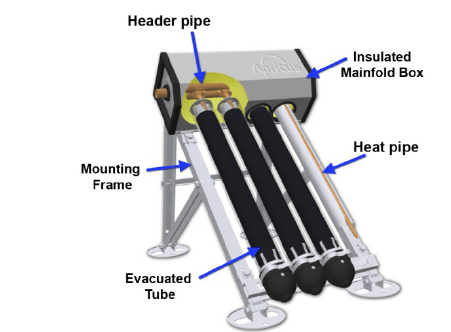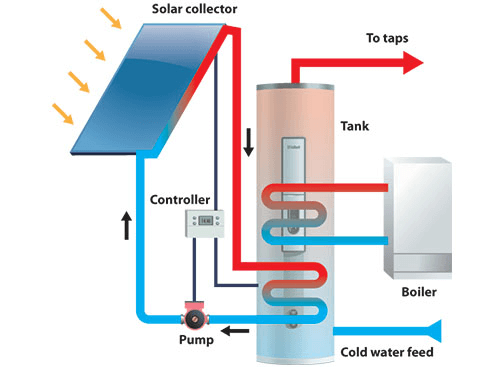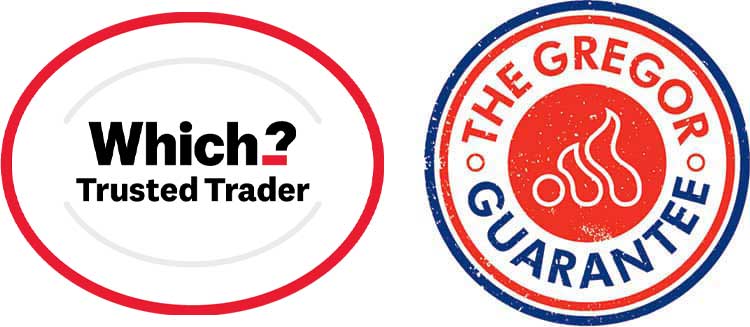- Is Solar Thermal for Me?
- How Does Solar Thermal Work?
- On-roof or in-roof Solar Thermal System?
- What Saving is there with a Solar Thermal System?
- Can I claim Renewable Heat Incentive for Solar Thermal?
- Do I need to maintain a Solar Thermal system?
- Contact Gregor about Solar Thermal installations
Is Solar Thermal for me?
Solar thermal is ideal for clients with high summer-time hot water demand, such as swimming pools, or shower blocks at campsites and holiday accommodation.
How does Solar Thermal work?
Solar thermal systems collect heat energy from a solar collector fitted typically on a south-facing roof. (East-West systems can be fitted).
There are two types of collector for typical domestic uses: flat plate collectors and solar evacuated tubes (other collector types are available for swimming pools)


The collector is connected to a solar pump station by solar-rated flow and return pipework. The pipework connects the pump station to the solar cylinder. This is typically a twin-coiled cylinder – the lower coil is the solar coil, and the upper coil is either a heat pump coil or a fossil fuel boiler coil (depending on the type of cylinder).
The solar controller switches the solar pump on and off depending on the temperature of the collector and the temperature at the bottom of the cylinder – temperature sensors are fitted to the solar collector and solar cylinder.
When there is approximately 7ºC of temperature difference between the roof and the cylinder, the pump switches on and transfers the heated fluid to the bottom of the cylinder. Heat transfer takes place within the coil from the solar primary circuit to the water in the bottom of the hot water cylinder.

The solar primary circuit is a continuous flow and return loop, and the fluid within the pipework is water mixed with an anti-freeze called glycol. This ensures that the fluid does not freeze and crack the collector in Winter.
On-roof or In-roof Solar Thermal System?
Similarly to solar PV, solar thermal can be either on-roof mounted or in-roof mounted. In-roof is a tidier installation: the flow and return pipe from the collector is hidden on the roof; and this system looks especially good on slate roofs. In-roof also works slightly more efficiently as the collector experiences less wind losses.
On-roof is a cheaper installation and is generally installed as a renovation or retrofit system.
What saving is there with a Solar Thermal system?
A solar thermal system should provide around 60% of a domestic hot water requirement. This will provide a financial saving and also a carbon saving, the amount depending on the fuel type.
Can I claim Renewable Heat Incentive for Solar Thermal?
Yes you can currently claim for the domestic Renewable Heat Incentive for Solar Thermal. The payments are based on the Domestic Hot Water kWh figure on the property Energy Performance Certificate (EPC). In fact you can claim twice for RHI for hot water if you have a heat pump and solar thermal. The payments are reviewed quarterly depending on number of installations carried out in the last quarter compared with the government’s targets. Payments are made quarterly over a seven-year period.
See the latest RHI tariffs for solar thermal below:
Do I need to maintain a Solar Thermal system?
The system should be checked every two to three years to make sure that there are no leaks and that everything is working correctly with correct settings on the solar controller.
Gregor systems are installed with twin-walled solar-rated flexible pipe, and so there are no joints on any pipework, only compression fittings to the collector, pump station and cylinder.
To make sure that your system is protected during frost periods, we also recommend checking the pH value of the glycol, as this can slowly degrade with repeated heat cycles.
Contact Gregor about Solar Thermal Installations
Are you interested in getting a solar thermal energy system installed in your home or premises? Don’t delay, call Gregor today on 0117 935 2400, and ask to speak to our Renewables team. We look forward to discussing your solar thermal needs with you and to booking you in for a survey if you would like one!




